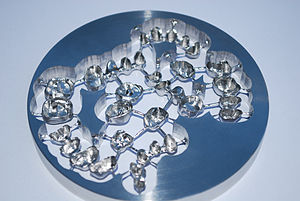
CAD/CAM dentistry is a field of dentistry and prosthodontics using CAD/CAM (computer-aided-design and computer-aided-manufacturing) to improve the design and creation of dental restorations,[1][2] especially dental prostheses, including crowns, crown lays, veneers, inlays and onlays, fixed dental prostheses (bridges), dental implant supported restorations, dentures (removable or fixed), and orthodontic appliances. CAD/CAM technology allows the delivery of a well-fitting, aesthetic, and a durable prostheses for the patient.[3] CAD/CAM complements earlier technologies used for these purposes by any combination of increasing the speed of design and creation; increasing the convenience or simplicity of the design, creation, and insertion processes; and making possible restorations and appliances that otherwise would have been infeasible. Other goals include reducing unit cost and making affordable restorations and appliances that otherwise would have been prohibitively expensive. However, to date, chairside CAD/CAM often involves extra time on the part of the dentist, and the fee is often at least two times higher than for conventional restorative treatments using lab services.
Like other CAD/CAM fields, CAD/CAM dentistry uses subtractive processes (such as CNC milling) [4] and additive processes (such as 3D printing) to produce physical instances from 3D models.
Some mentions of "CAD/CAM" and "milling technology" in dental technology have loosely treated those two terms as if they were interchangeable, largely because before the 2010s, most CAD/CAM-directed manufacturing was CNC cutting, not additive manufacturing, so CAD/CAM and CNC were usually coinstantiated; but whereas this loose/imprecise usage was once somewhat close to accurate, it no longer is, as the term "CAD/CAM" does not specify the method of production except that whatever method is used takes input from CAD/CAM,[5] and today additive and subtractive methods are both widely used.
- ^ Davidowitz G, Kotick PG. (2011), "The use of CAD/CAM in dentistry.", Dent Clin North Am, 55 (3): 559–570, doi:10.1016/j.cden.2011.02.011, PMID 21726690.
- ^ Rekow D (1987), "Computer-aided design and manufacturing in dentistry: a review of the state of the art", J Prosthet Dent, 58 (4): 512–516, doi:10.1016/0022-3913(87)90285-X, PMID 3312586.
- ^ Oen, Kay T; Veitz-Keenan, Analia; Spivakovsky, Silvia; Wong, Y Jo; Bakarman, Eman; Yip, Julie (April 9, 2014). "CAD/CAM versus traditional indirect methods in the fabrication of inlays, onlays, and crowns". Cochrane Database of Systematic Reviews. doi:10.1002/14651858.cd011063. ISSN 1465-1858.
- ^ Kastyl, Jaroslav; Chlup, Zdenek; Stastny, Premysl; Trunec, Martin (August 17, 2020). "Machinability and properties of zirconia ceramics prepared by gelcasting method". Advances in Applied Ceramics. 119 (5–6): 252–260. Bibcode:2020AdApC.119..252K. doi:10.1080/17436753.2019.1675402. hdl:11012/181089. ISSN 1743-6753. S2CID 210795876.
- ^ Cite error: The named reference
:0was invoked but never defined (see the help page).